Microeconomics Principles: ECON111 Assignment on Operation Barga
VerifiedAdded on 2022/12/26
|13
|2874
|1
Homework Assignment
AI Summary
This assignment analyzes the microeconomic principles behind Operation Barga, a land reform initiative in West Bengal, India. It examines the economic incentives provided to farmers, the ethical perspectives (consequentialism and deontological ethics) justifying the policy, and its impact on Pareto efficiency and improvement. The assignment explores how the policy affected sharecroppers, landowners, and overall agricultural output. It also includes graphical representations illustrating the optimal choices of farmers, both as independent landowners and as sharecroppers, and evaluates the fairness of the outcomes in each scenario. The solution highlights the role of government intervention in addressing market failures and promoting economic development, referencing relevant economic concepts and literature to support the analysis.
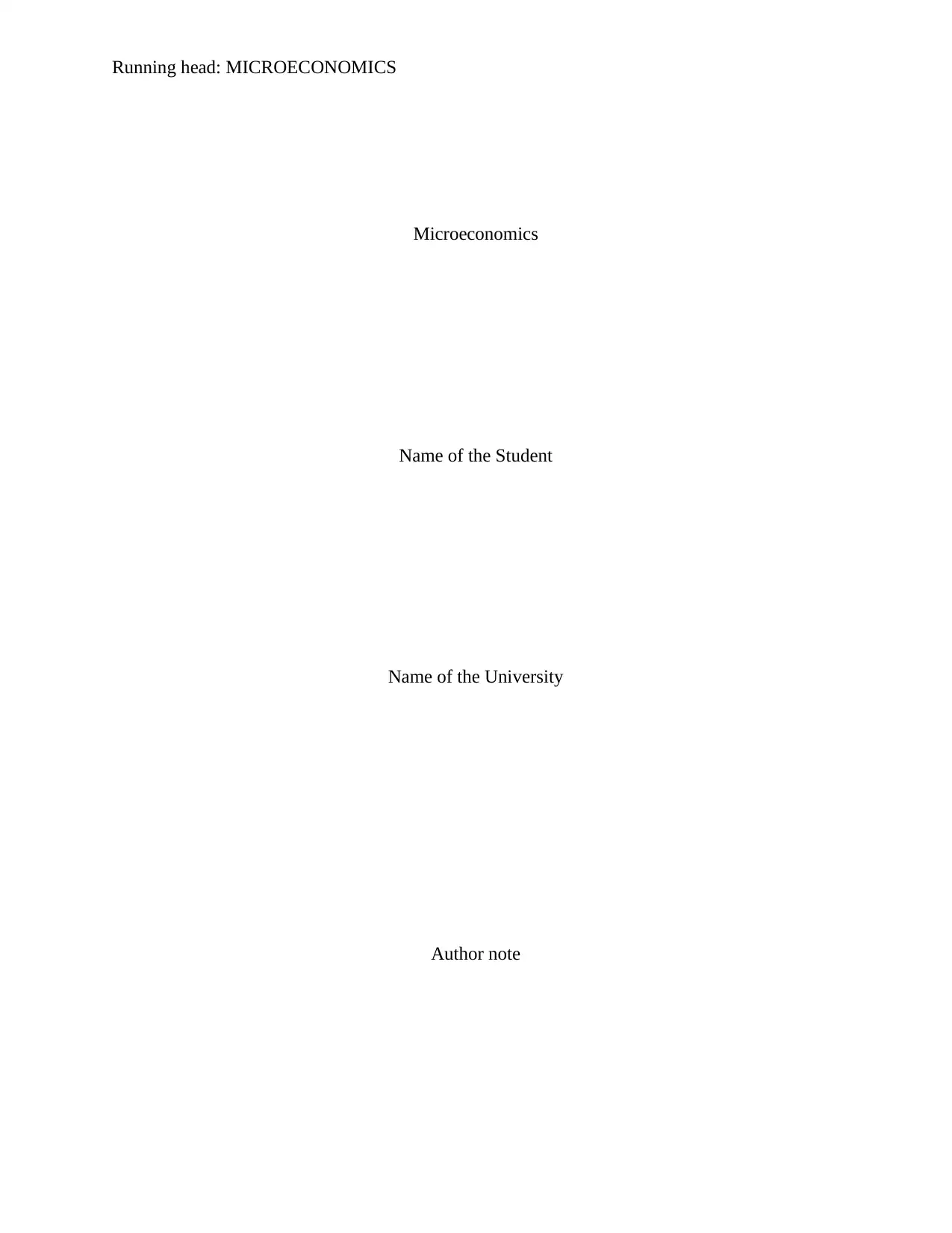
Running head: MICROECONOMICS
Microeconomics
Name of the Student
Name of the University
Author note
Microeconomics
Name of the Student
Name of the University
Author note
Secure Best Marks with AI Grader
Need help grading? Try our AI Grader for instant feedback on your assignments.
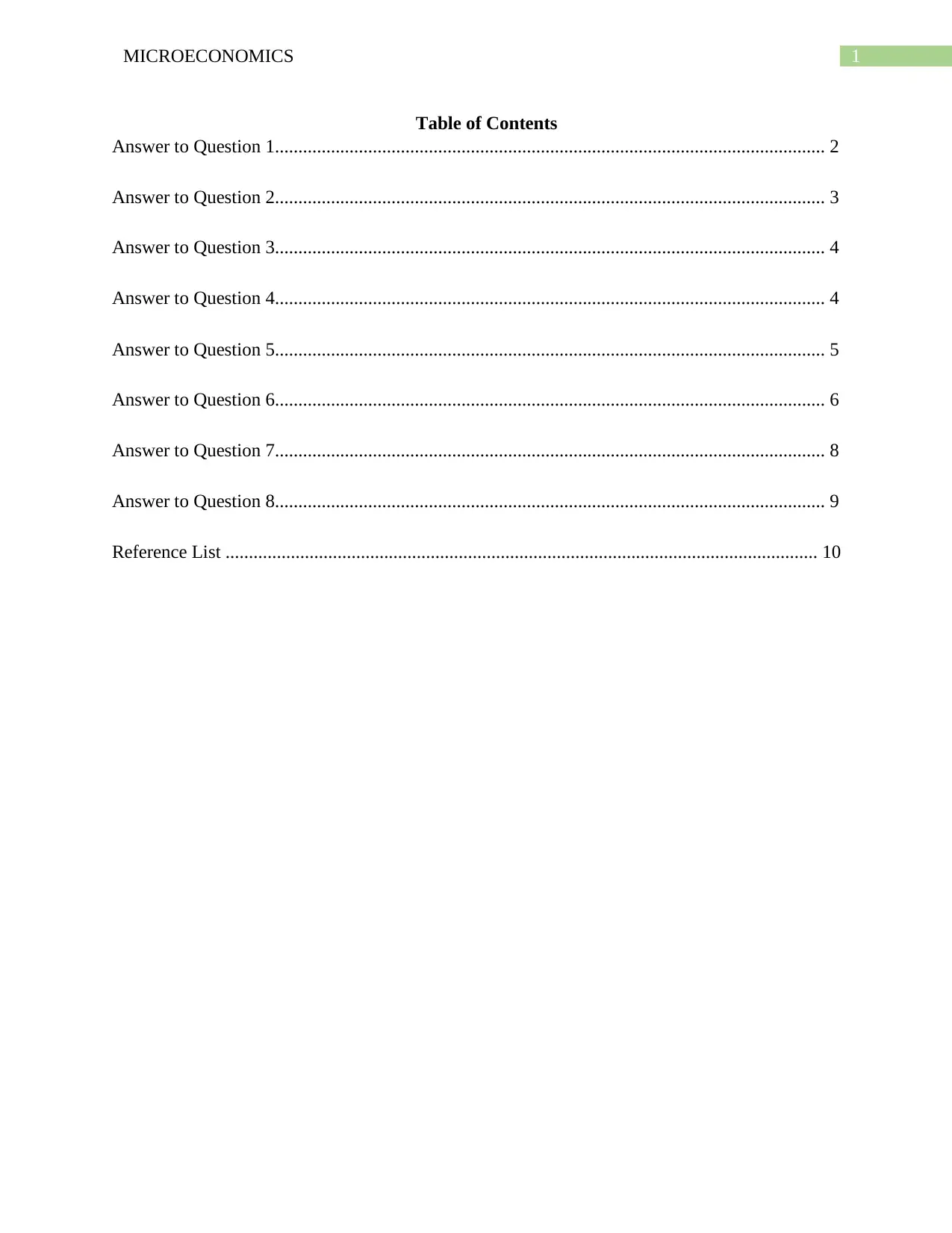
1MICROECONOMICS
Table of Contents
Answer to Question 1...................................................................................................................... 2
Answer to Question 2...................................................................................................................... 3
Answer to Question 3...................................................................................................................... 4
Answer to Question 4...................................................................................................................... 4
Answer to Question 5...................................................................................................................... 5
Answer to Question 6...................................................................................................................... 6
Answer to Question 7...................................................................................................................... 8
Answer to Question 8...................................................................................................................... 9
Reference List ............................................................................................................................... 10
Table of Contents
Answer to Question 1...................................................................................................................... 2
Answer to Question 2...................................................................................................................... 3
Answer to Question 3...................................................................................................................... 4
Answer to Question 4...................................................................................................................... 4
Answer to Question 5...................................................................................................................... 5
Answer to Question 6...................................................................................................................... 6
Answer to Question 7...................................................................................................................... 8
Answer to Question 8...................................................................................................................... 9
Reference List ............................................................................................................................... 10
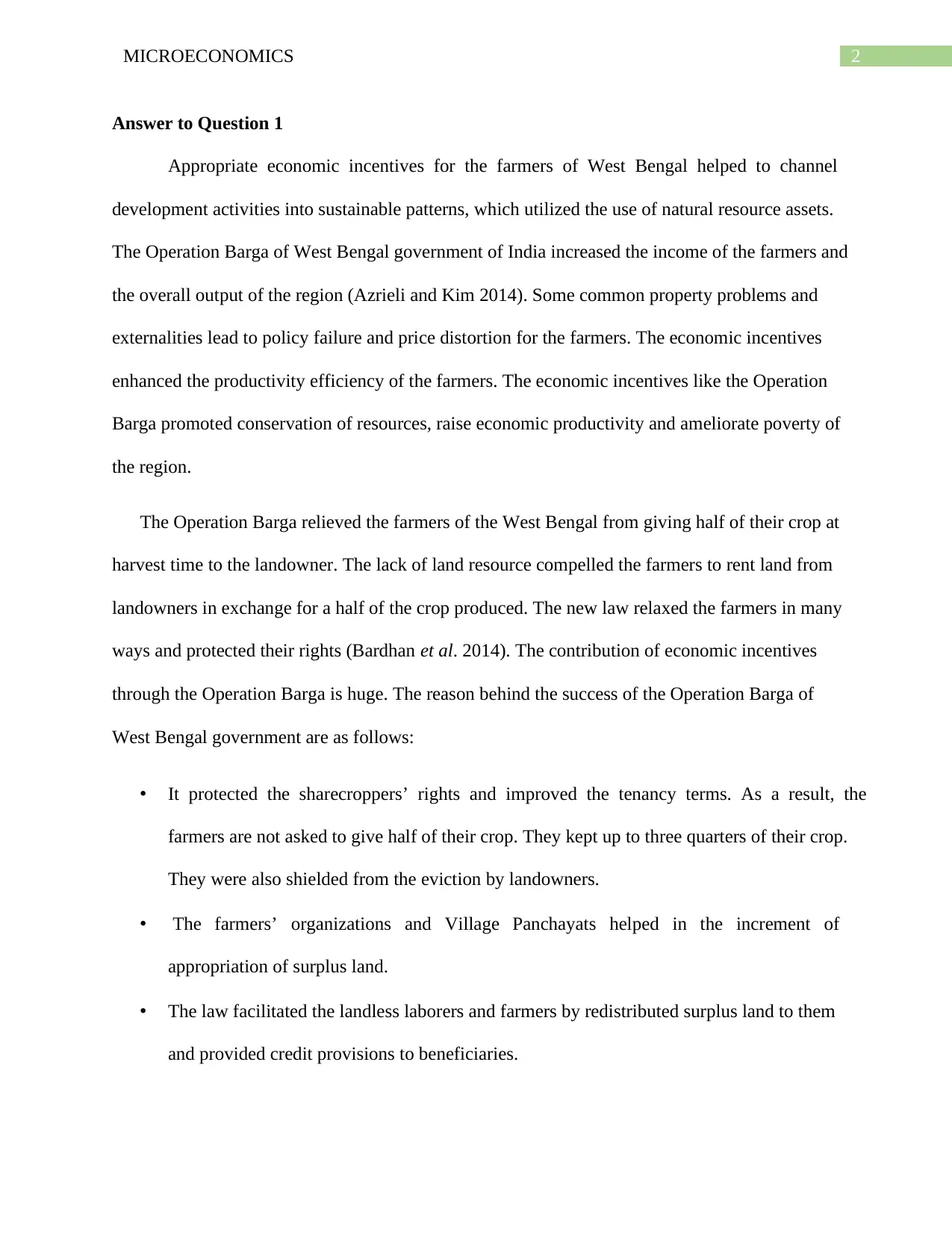
2MICROECONOMICS
Answer to Question 1
Appropriate economic incentives for the farmers of West Bengal helped to channel
development activities into sustainable patterns, which utilized the use of natural resource assets.
The Operation Barga of West Bengal government of India increased the income of the farmers and
the overall output of the region (Azrieli and Kim 2014). Some common property problems and
externalities lead to policy failure and price distortion for the farmers. The economic incentives
enhanced the productivity efficiency of the farmers. The economic incentives like the Operation
Barga promoted conservation of resources, raise economic productivity and ameliorate poverty of
the region.
The Operation Barga relieved the farmers of the West Bengal from giving half of their crop at
harvest time to the landowner. The lack of land resource compelled the farmers to rent land from
landowners in exchange for a half of the crop produced. The new law relaxed the farmers in many
ways and protected their rights (Bardhan et al. 2014). The contribution of economic incentives
through the Operation Barga is huge. The reason behind the success of the Operation Barga of
West Bengal government are as follows:
• It protected the sharecroppers’ rights and improved the tenancy terms. As a result, the
farmers are not asked to give half of their crop. They kept up to three quarters of their crop.
They were also shielded from the eviction by landowners.
• The farmers’ organizations and Village Panchayats helped in the increment of
appropriation of surplus land.
• The law facilitated the landless laborers and farmers by redistributed surplus land to them
and provided credit provisions to beneficiaries.
Answer to Question 1
Appropriate economic incentives for the farmers of West Bengal helped to channel
development activities into sustainable patterns, which utilized the use of natural resource assets.
The Operation Barga of West Bengal government of India increased the income of the farmers and
the overall output of the region (Azrieli and Kim 2014). Some common property problems and
externalities lead to policy failure and price distortion for the farmers. The economic incentives
enhanced the productivity efficiency of the farmers. The economic incentives like the Operation
Barga promoted conservation of resources, raise economic productivity and ameliorate poverty of
the region.
The Operation Barga relieved the farmers of the West Bengal from giving half of their crop at
harvest time to the landowner. The lack of land resource compelled the farmers to rent land from
landowners in exchange for a half of the crop produced. The new law relaxed the farmers in many
ways and protected their rights (Bardhan et al. 2014). The contribution of economic incentives
through the Operation Barga is huge. The reason behind the success of the Operation Barga of
West Bengal government are as follows:
• It protected the sharecroppers’ rights and improved the tenancy terms. As a result, the
farmers are not asked to give half of their crop. They kept up to three quarters of their crop.
They were also shielded from the eviction by landowners.
• The farmers’ organizations and Village Panchayats helped in the increment of
appropriation of surplus land.
• The law facilitated the landless laborers and farmers by redistributed surplus land to them
and provided credit provisions to beneficiaries.
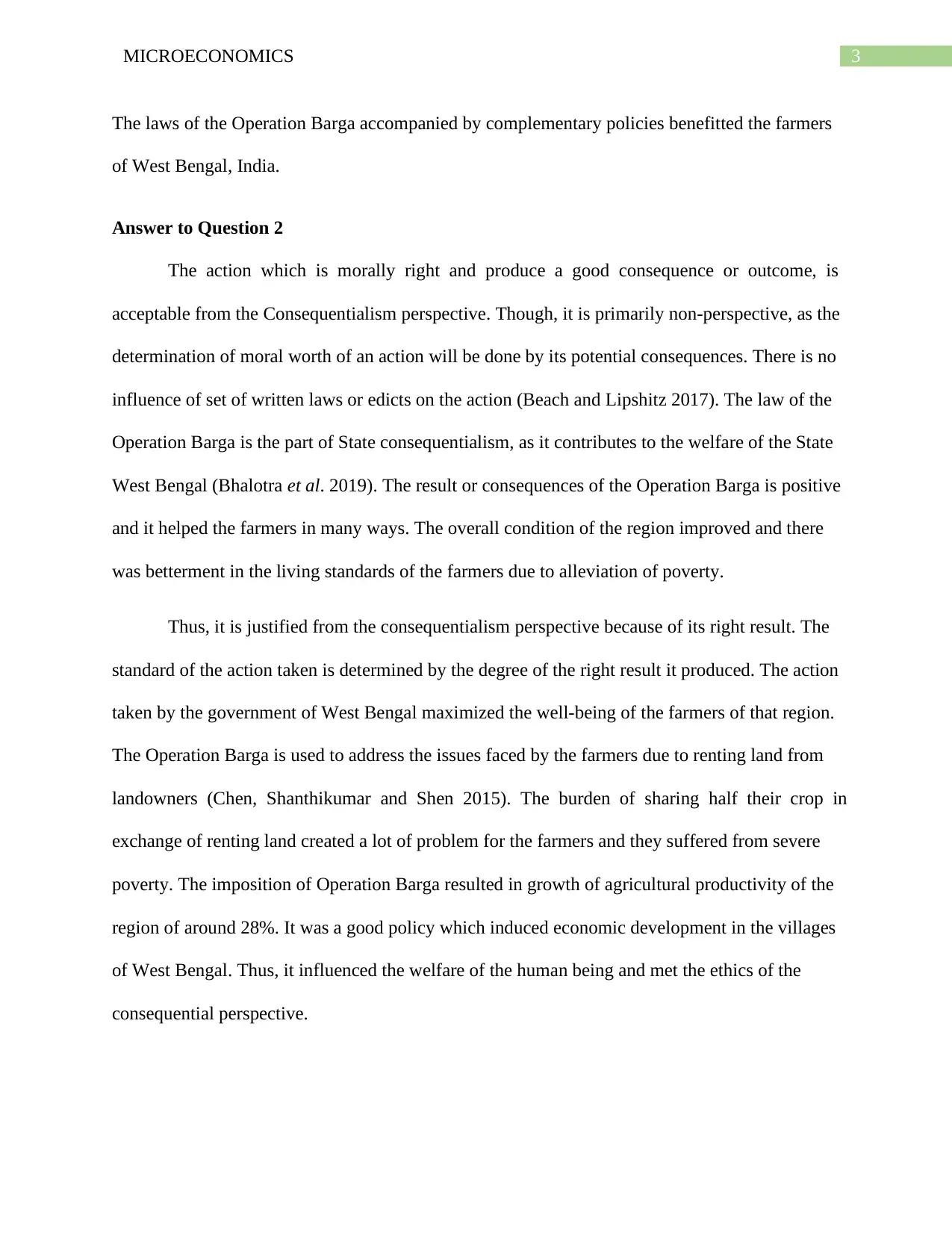
3MICROECONOMICS
The laws of the Operation Barga accompanied by complementary policies benefitted the farmers
of West Bengal, India.
Answer to Question 2
The action which is morally right and produce a good consequence or outcome, is
acceptable from the Consequentialism perspective. Though, it is primarily non-perspective, as the
determination of moral worth of an action will be done by its potential consequences. There is no
influence of set of written laws or edicts on the action (Beach and Lipshitz 2017). The law of the
Operation Barga is the part of State consequentialism, as it contributes to the welfare of the State
West Bengal (Bhalotra et al. 2019). The result or consequences of the Operation Barga is positive
and it helped the farmers in many ways. The overall condition of the region improved and there
was betterment in the living standards of the farmers due to alleviation of poverty.
Thus, it is justified from the consequentialism perspective because of its right result. The
standard of the action taken is determined by the degree of the right result it produced. The action
taken by the government of West Bengal maximized the well-being of the farmers of that region.
The Operation Barga is used to address the issues faced by the farmers due to renting land from
landowners (Chen, Shanthikumar and Shen 2015). The burden of sharing half their crop in
exchange of renting land created a lot of problem for the farmers and they suffered from severe
poverty. The imposition of Operation Barga resulted in growth of agricultural productivity of the
region of around 28%. It was a good policy which induced economic development in the villages
of West Bengal. Thus, it influenced the welfare of the human being and met the ethics of the
consequential perspective.
The laws of the Operation Barga accompanied by complementary policies benefitted the farmers
of West Bengal, India.
Answer to Question 2
The action which is morally right and produce a good consequence or outcome, is
acceptable from the Consequentialism perspective. Though, it is primarily non-perspective, as the
determination of moral worth of an action will be done by its potential consequences. There is no
influence of set of written laws or edicts on the action (Beach and Lipshitz 2017). The law of the
Operation Barga is the part of State consequentialism, as it contributes to the welfare of the State
West Bengal (Bhalotra et al. 2019). The result or consequences of the Operation Barga is positive
and it helped the farmers in many ways. The overall condition of the region improved and there
was betterment in the living standards of the farmers due to alleviation of poverty.
Thus, it is justified from the consequentialism perspective because of its right result. The
standard of the action taken is determined by the degree of the right result it produced. The action
taken by the government of West Bengal maximized the well-being of the farmers of that region.
The Operation Barga is used to address the issues faced by the farmers due to renting land from
landowners (Chen, Shanthikumar and Shen 2015). The burden of sharing half their crop in
exchange of renting land created a lot of problem for the farmers and they suffered from severe
poverty. The imposition of Operation Barga resulted in growth of agricultural productivity of the
region of around 28%. It was a good policy which induced economic development in the villages
of West Bengal. Thus, it influenced the welfare of the human being and met the ethics of the
consequential perspective.
Secure Best Marks with AI Grader
Need help grading? Try our AI Grader for instant feedback on your assignments.
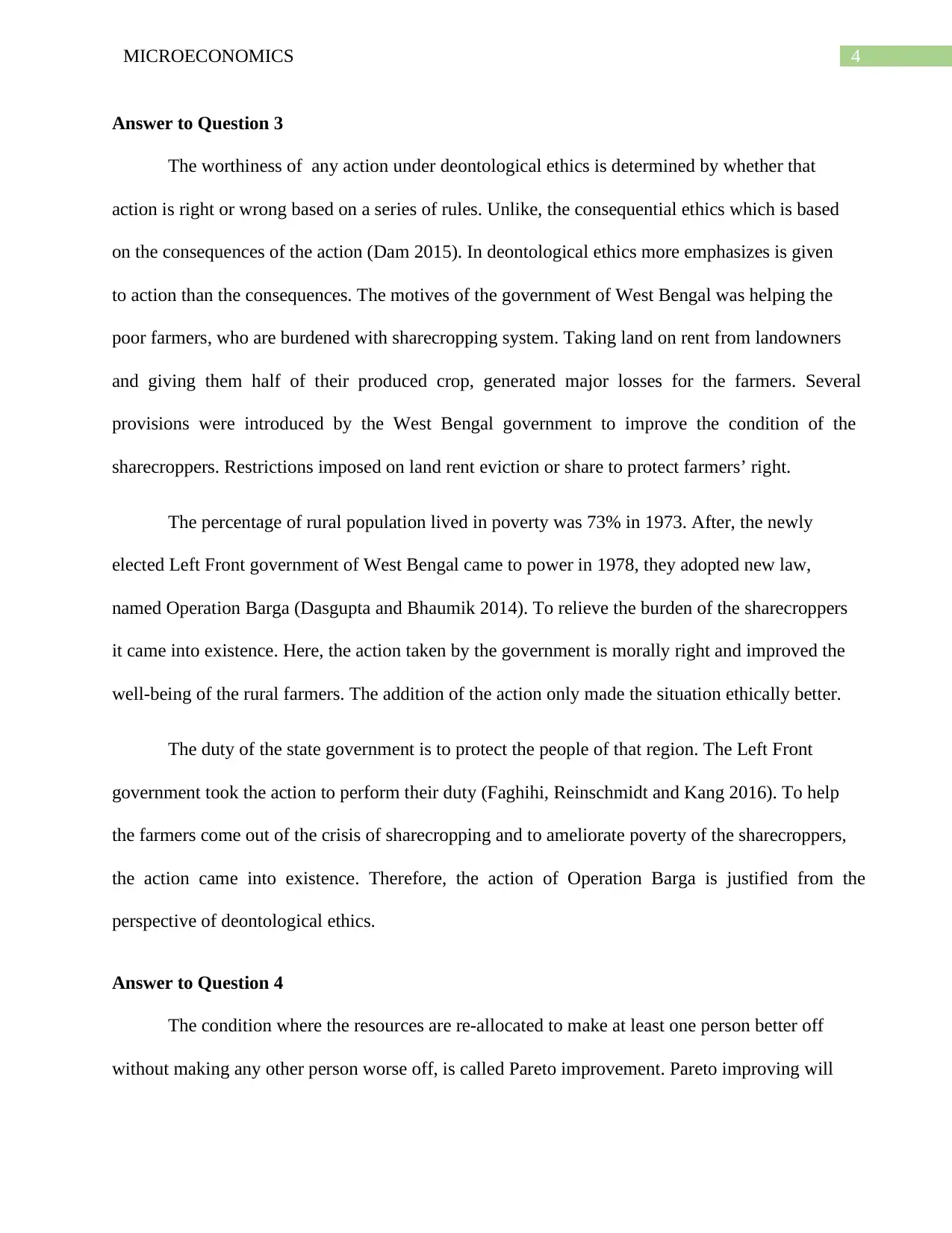
4MICROECONOMICS
Answer to Question 3
The worthiness of any action under deontological ethics is determined by whether that
action is right or wrong based on a series of rules. Unlike, the consequential ethics which is based
on the consequences of the action (Dam 2015). In deontological ethics more emphasizes is given
to action than the consequences. The motives of the government of West Bengal was helping the
poor farmers, who are burdened with sharecropping system. Taking land on rent from landowners
and giving them half of their produced crop, generated major losses for the farmers. Several
provisions were introduced by the West Bengal government to improve the condition of the
sharecroppers. Restrictions imposed on land rent eviction or share to protect farmers’ right.
The percentage of rural population lived in poverty was 73% in 1973. After, the newly
elected Left Front government of West Bengal came to power in 1978, they adopted new law,
named Operation Barga (Dasgupta and Bhaumik 2014). To relieve the burden of the sharecroppers
it came into existence. Here, the action taken by the government is morally right and improved the
well-being of the rural farmers. The addition of the action only made the situation ethically better.
The duty of the state government is to protect the people of that region. The Left Front
government took the action to perform their duty (Faghihi, Reinschmidt and Kang 2016). To help
the farmers come out of the crisis of sharecropping and to ameliorate poverty of the sharecroppers,
the action came into existence. Therefore, the action of Operation Barga is justified from the
perspective of deontological ethics.
Answer to Question 4
The condition where the resources are re-allocated to make at least one person better off
without making any other person worse off, is called Pareto improvement. Pareto improving will
Answer to Question 3
The worthiness of any action under deontological ethics is determined by whether that
action is right or wrong based on a series of rules. Unlike, the consequential ethics which is based
on the consequences of the action (Dam 2015). In deontological ethics more emphasizes is given
to action than the consequences. The motives of the government of West Bengal was helping the
poor farmers, who are burdened with sharecropping system. Taking land on rent from landowners
and giving them half of their produced crop, generated major losses for the farmers. Several
provisions were introduced by the West Bengal government to improve the condition of the
sharecroppers. Restrictions imposed on land rent eviction or share to protect farmers’ right.
The percentage of rural population lived in poverty was 73% in 1973. After, the newly
elected Left Front government of West Bengal came to power in 1978, they adopted new law,
named Operation Barga (Dasgupta and Bhaumik 2014). To relieve the burden of the sharecroppers
it came into existence. Here, the action taken by the government is morally right and improved the
well-being of the rural farmers. The addition of the action only made the situation ethically better.
The duty of the state government is to protect the people of that region. The Left Front
government took the action to perform their duty (Faghihi, Reinschmidt and Kang 2016). To help
the farmers come out of the crisis of sharecropping and to ameliorate poverty of the sharecroppers,
the action came into existence. Therefore, the action of Operation Barga is justified from the
perspective of deontological ethics.
Answer to Question 4
The condition where the resources are re-allocated to make at least one person better off
without making any other person worse off, is called Pareto improvement. Pareto improving will
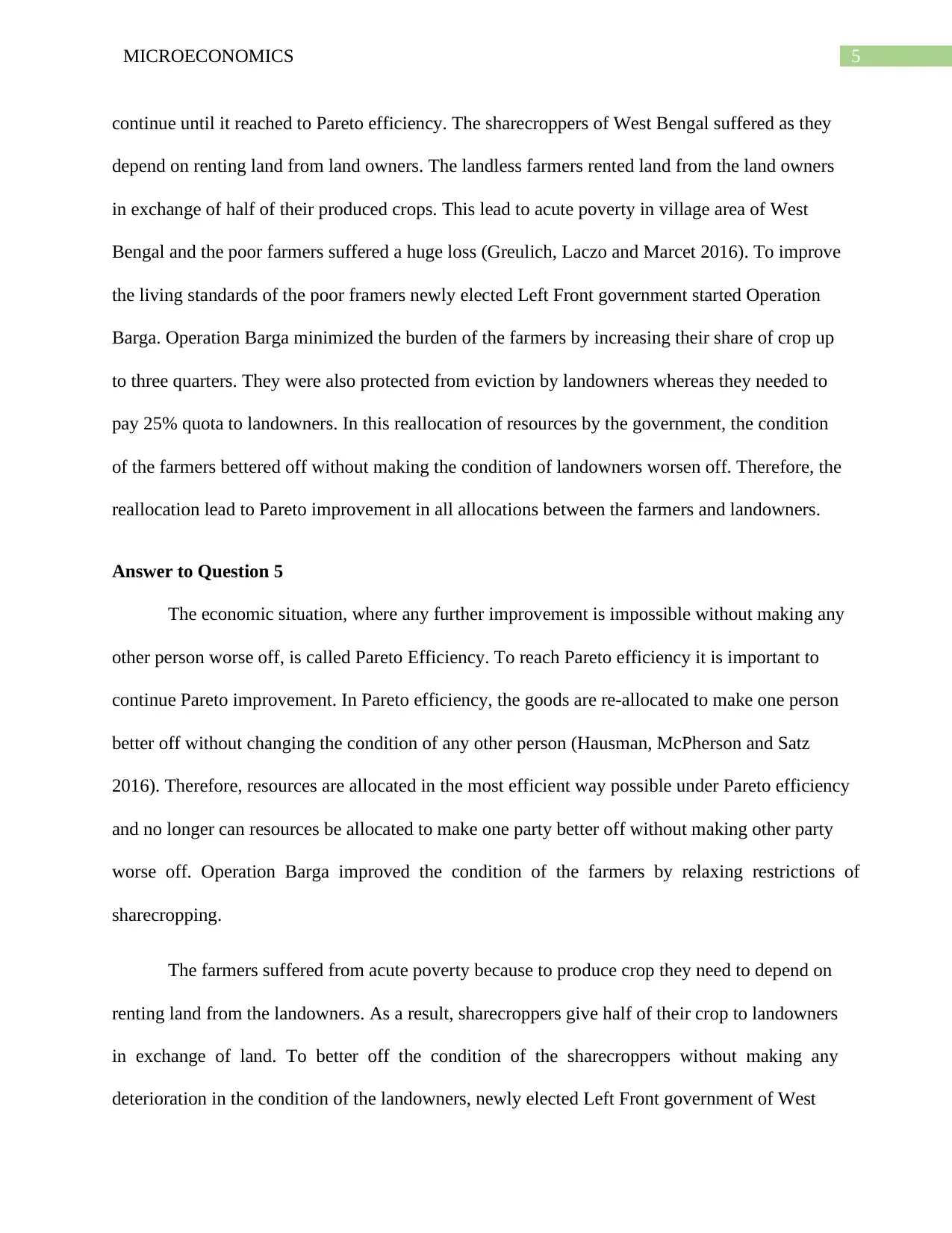
5MICROECONOMICS
continue until it reached to Pareto efficiency. The sharecroppers of West Bengal suffered as they
depend on renting land from land owners. The landless farmers rented land from the land owners
in exchange of half of their produced crops. This lead to acute poverty in village area of West
Bengal and the poor farmers suffered a huge loss (Greulich, Laczo and Marcet 2016). To improve
the living standards of the poor framers newly elected Left Front government started Operation
Barga. Operation Barga minimized the burden of the farmers by increasing their share of crop up
to three quarters. They were also protected from eviction by landowners whereas they needed to
pay 25% quota to landowners. In this reallocation of resources by the government, the condition
of the farmers bettered off without making the condition of landowners worsen off. Therefore, the
reallocation lead to Pareto improvement in all allocations between the farmers and landowners.
Answer to Question 5
The economic situation, where any further improvement is impossible without making any
other person worse off, is called Pareto Efficiency. To reach Pareto efficiency it is important to
continue Pareto improvement. In Pareto efficiency, the goods are re-allocated to make one person
better off without changing the condition of any other person (Hausman, McPherson and Satz
2016). Therefore, resources are allocated in the most efficient way possible under Pareto efficiency
and no longer can resources be allocated to make one party better off without making other party
worse off. Operation Barga improved the condition of the farmers by relaxing restrictions of
sharecropping.
The farmers suffered from acute poverty because to produce crop they need to depend on
renting land from the landowners. As a result, sharecroppers give half of their crop to landowners
in exchange of land. To better off the condition of the sharecroppers without making any
deterioration in the condition of the landowners, newly elected Left Front government of West
continue until it reached to Pareto efficiency. The sharecroppers of West Bengal suffered as they
depend on renting land from land owners. The landless farmers rented land from the land owners
in exchange of half of their produced crops. This lead to acute poverty in village area of West
Bengal and the poor farmers suffered a huge loss (Greulich, Laczo and Marcet 2016). To improve
the living standards of the poor framers newly elected Left Front government started Operation
Barga. Operation Barga minimized the burden of the farmers by increasing their share of crop up
to three quarters. They were also protected from eviction by landowners whereas they needed to
pay 25% quota to landowners. In this reallocation of resources by the government, the condition
of the farmers bettered off without making the condition of landowners worsen off. Therefore, the
reallocation lead to Pareto improvement in all allocations between the farmers and landowners.
Answer to Question 5
The economic situation, where any further improvement is impossible without making any
other person worse off, is called Pareto Efficiency. To reach Pareto efficiency it is important to
continue Pareto improvement. In Pareto efficiency, the goods are re-allocated to make one person
better off without changing the condition of any other person (Hausman, McPherson and Satz
2016). Therefore, resources are allocated in the most efficient way possible under Pareto efficiency
and no longer can resources be allocated to make one party better off without making other party
worse off. Operation Barga improved the condition of the farmers by relaxing restrictions of
sharecropping.
The farmers suffered from acute poverty because to produce crop they need to depend on
renting land from the landowners. As a result, sharecroppers give half of their crop to landowners
in exchange of land. To better off the condition of the sharecroppers without making any
deterioration in the condition of the landowners, newly elected Left Front government of West
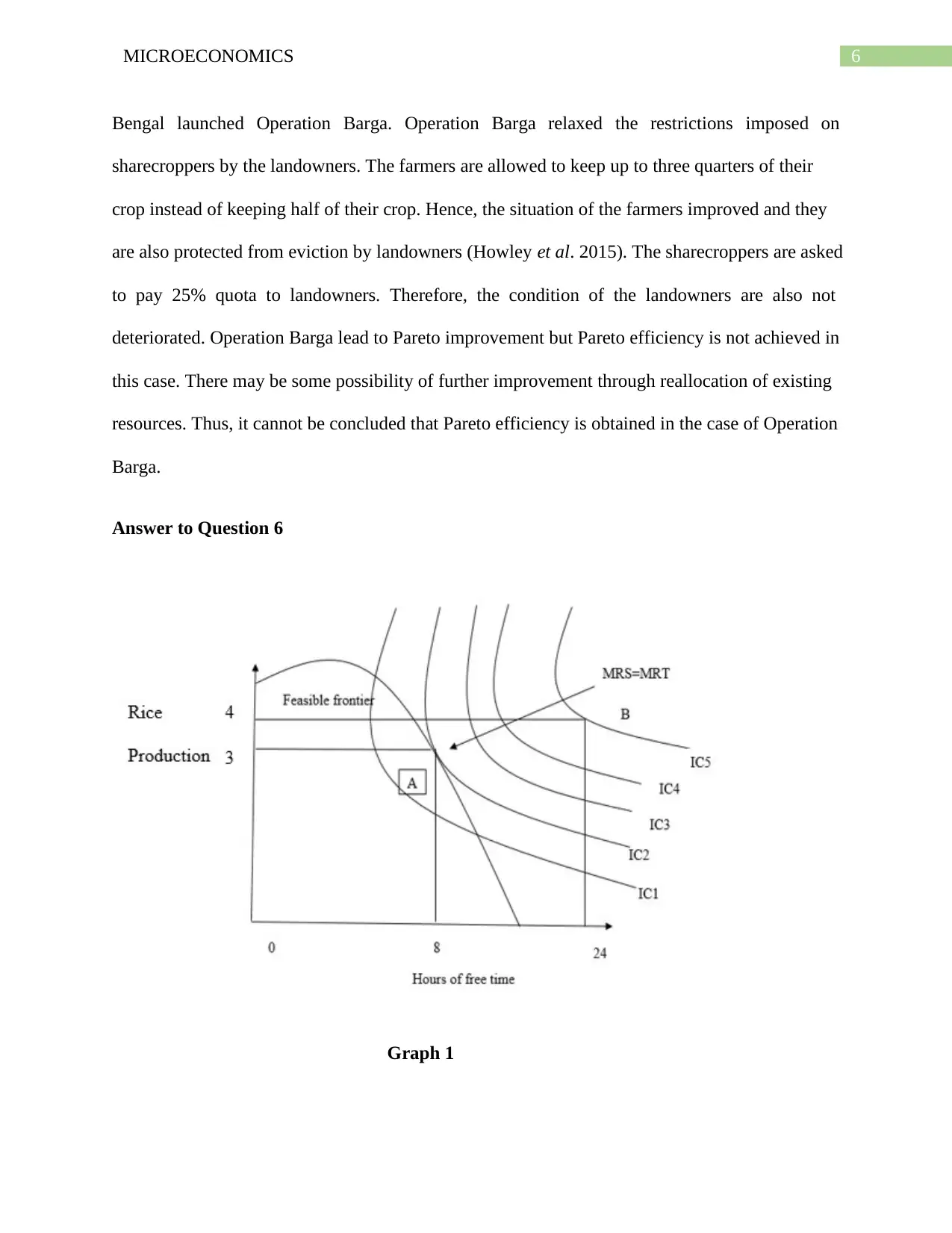
6MICROECONOMICS
Bengal launched Operation Barga. Operation Barga relaxed the restrictions imposed on
sharecroppers by the landowners. The farmers are allowed to keep up to three quarters of their
crop instead of keeping half of their crop. Hence, the situation of the farmers improved and they
are also protected from eviction by landowners (Howley et al. 2015). The sharecroppers are asked
to pay 25% quota to landowners. Therefore, the condition of the landowners are also not
deteriorated. Operation Barga lead to Pareto improvement but Pareto efficiency is not achieved in
this case. There may be some possibility of further improvement through reallocation of existing
resources. Thus, it cannot be concluded that Pareto efficiency is obtained in the case of Operation
Barga.
Answer to Question 6
Graph 1
Bengal launched Operation Barga. Operation Barga relaxed the restrictions imposed on
sharecroppers by the landowners. The farmers are allowed to keep up to three quarters of their
crop instead of keeping half of their crop. Hence, the situation of the farmers improved and they
are also protected from eviction by landowners (Howley et al. 2015). The sharecroppers are asked
to pay 25% quota to landowners. Therefore, the condition of the landowners are also not
deteriorated. Operation Barga lead to Pareto improvement but Pareto efficiency is not achieved in
this case. There may be some possibility of further improvement through reallocation of existing
resources. Thus, it cannot be concluded that Pareto efficiency is obtained in the case of Operation
Barga.
Answer to Question 6
Graph 1
Paraphrase This Document
Need a fresh take? Get an instant paraphrase of this document with our AI Paraphraser
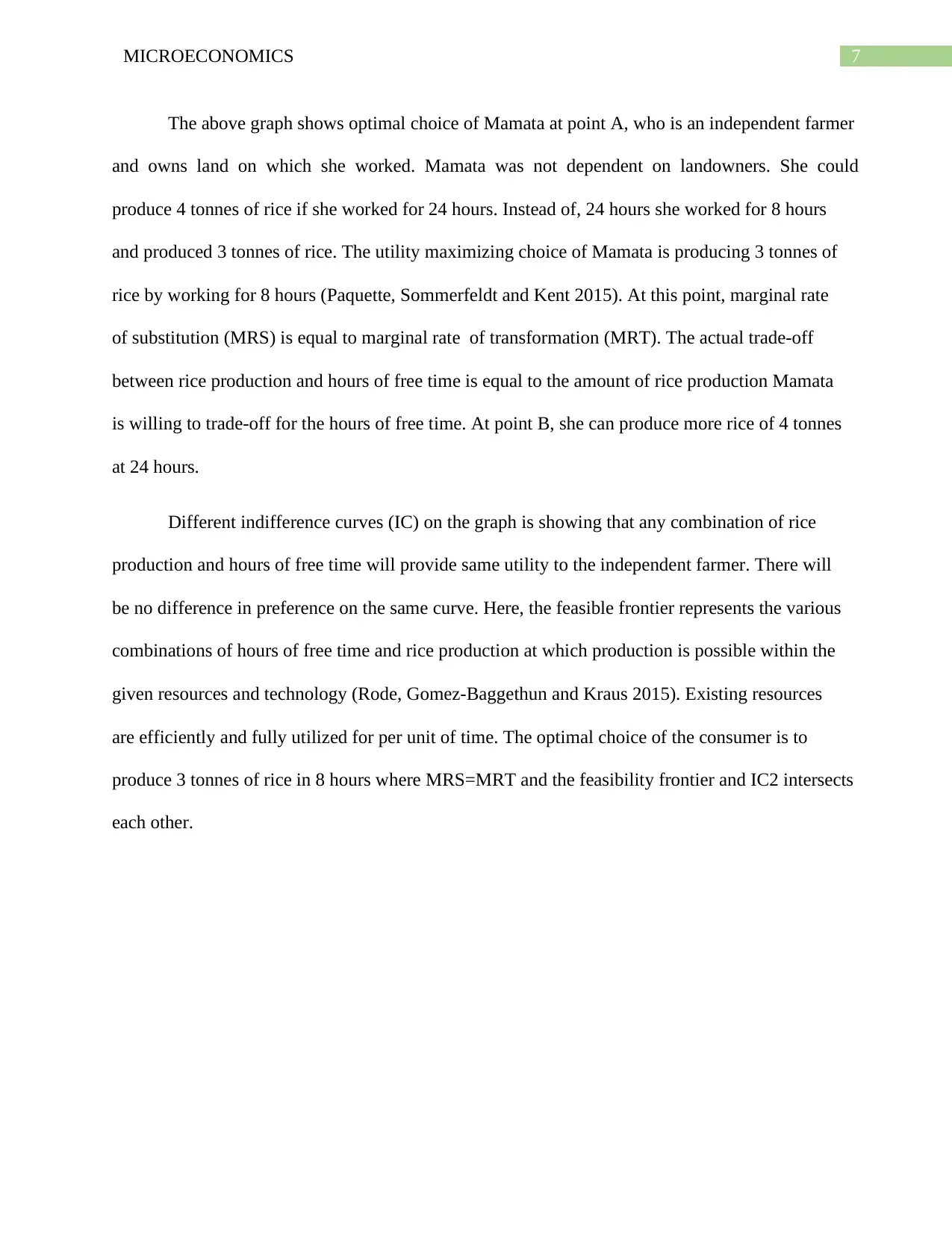
7MICROECONOMICS
The above graph shows optimal choice of Mamata at point A, who is an independent farmer
and owns land on which she worked. Mamata was not dependent on landowners. She could
produce 4 tonnes of rice if she worked for 24 hours. Instead of, 24 hours she worked for 8 hours
and produced 3 tonnes of rice. The utility maximizing choice of Mamata is producing 3 tonnes of
rice by working for 8 hours (Paquette, Sommerfeldt and Kent 2015). At this point, marginal rate
of substitution (MRS) is equal to marginal rate of transformation (MRT). The actual trade-off
between rice production and hours of free time is equal to the amount of rice production Mamata
is willing to trade-off for the hours of free time. At point B, she can produce more rice of 4 tonnes
at 24 hours.
Different indifference curves (IC) on the graph is showing that any combination of rice
production and hours of free time will provide same utility to the independent farmer. There will
be no difference in preference on the same curve. Here, the feasible frontier represents the various
combinations of hours of free time and rice production at which production is possible within the
given resources and technology (Rode, Gomez-Baggethun and Kraus 2015). Existing resources
are efficiently and fully utilized for per unit of time. The optimal choice of the consumer is to
produce 3 tonnes of rice in 8 hours where MRS=MRT and the feasibility frontier and IC2 intersects
each other.
The above graph shows optimal choice of Mamata at point A, who is an independent farmer
and owns land on which she worked. Mamata was not dependent on landowners. She could
produce 4 tonnes of rice if she worked for 24 hours. Instead of, 24 hours she worked for 8 hours
and produced 3 tonnes of rice. The utility maximizing choice of Mamata is producing 3 tonnes of
rice by working for 8 hours (Paquette, Sommerfeldt and Kent 2015). At this point, marginal rate
of substitution (MRS) is equal to marginal rate of transformation (MRT). The actual trade-off
between rice production and hours of free time is equal to the amount of rice production Mamata
is willing to trade-off for the hours of free time. At point B, she can produce more rice of 4 tonnes
at 24 hours.
Different indifference curves (IC) on the graph is showing that any combination of rice
production and hours of free time will provide same utility to the independent farmer. There will
be no difference in preference on the same curve. Here, the feasible frontier represents the various
combinations of hours of free time and rice production at which production is possible within the
given resources and technology (Rode, Gomez-Baggethun and Kraus 2015). Existing resources
are efficiently and fully utilized for per unit of time. The optimal choice of the consumer is to
produce 3 tonnes of rice in 8 hours where MRS=MRT and the feasibility frontier and IC2 intersects
each other.
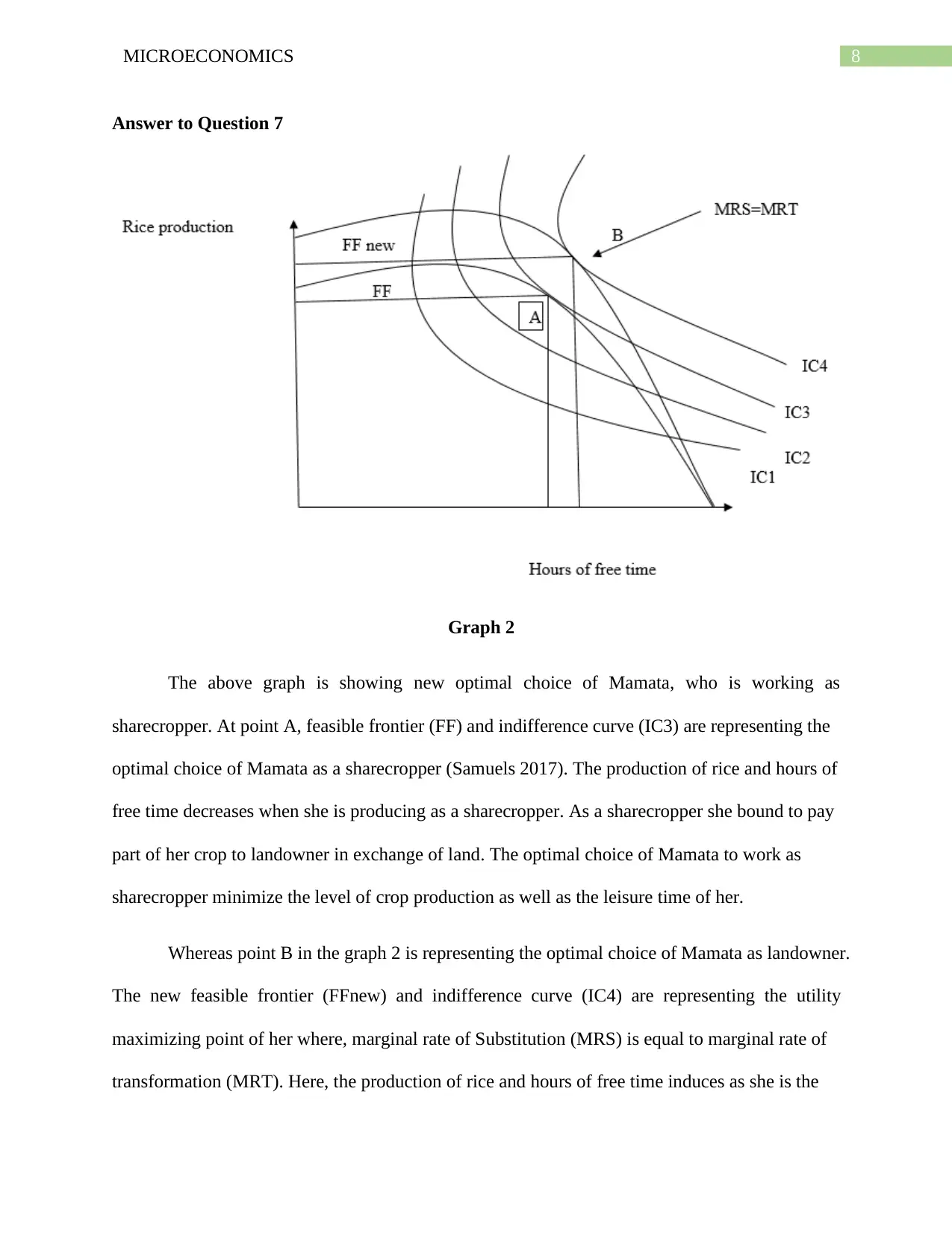
8MICROECONOMICS
Answer to Question 7
Graph 2
The above graph is showing new optimal choice of Mamata, who is working as
sharecropper. At point A, feasible frontier (FF) and indifference curve (IC3) are representing the
optimal choice of Mamata as a sharecropper (Samuels 2017). The production of rice and hours of
free time decreases when she is producing as a sharecropper. As a sharecropper she bound to pay
part of her crop to landowner in exchange of land. The optimal choice of Mamata to work as
sharecropper minimize the level of crop production as well as the leisure time of her.
Whereas point B in the graph 2 is representing the optimal choice of Mamata as landowner.
The new feasible frontier (FFnew) and indifference curve (IC4) are representing the utility
maximizing point of her where, marginal rate of Substitution (MRS) is equal to marginal rate of
transformation (MRT). Here, the production of rice and hours of free time induces as she is the
Answer to Question 7
Graph 2
The above graph is showing new optimal choice of Mamata, who is working as
sharecropper. At point A, feasible frontier (FF) and indifference curve (IC3) are representing the
optimal choice of Mamata as a sharecropper (Samuels 2017). The production of rice and hours of
free time decreases when she is producing as a sharecropper. As a sharecropper she bound to pay
part of her crop to landowner in exchange of land. The optimal choice of Mamata to work as
sharecropper minimize the level of crop production as well as the leisure time of her.
Whereas point B in the graph 2 is representing the optimal choice of Mamata as landowner.
The new feasible frontier (FFnew) and indifference curve (IC4) are representing the utility
maximizing point of her where, marginal rate of Substitution (MRS) is equal to marginal rate of
transformation (MRT). Here, the production of rice and hours of free time induces as she is the
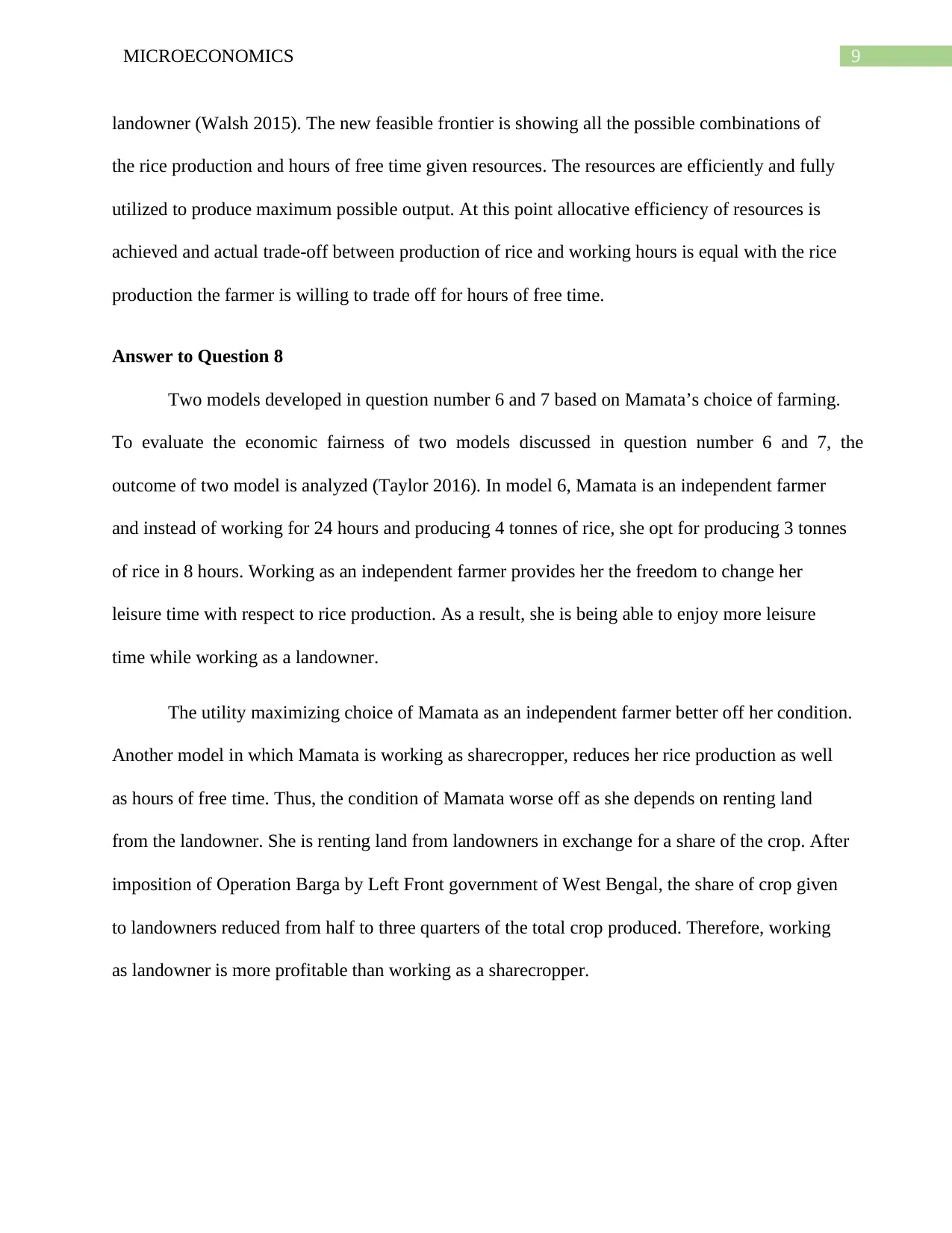
9MICROECONOMICS
landowner (Walsh 2015). The new feasible frontier is showing all the possible combinations of
the rice production and hours of free time given resources. The resources are efficiently and fully
utilized to produce maximum possible output. At this point allocative efficiency of resources is
achieved and actual trade-off between production of rice and working hours is equal with the rice
production the farmer is willing to trade off for hours of free time.
Answer to Question 8
Two models developed in question number 6 and 7 based on Mamata’s choice of farming.
To evaluate the economic fairness of two models discussed in question number 6 and 7, the
outcome of two model is analyzed (Taylor 2016). In model 6, Mamata is an independent farmer
and instead of working for 24 hours and producing 4 tonnes of rice, she opt for producing 3 tonnes
of rice in 8 hours. Working as an independent farmer provides her the freedom to change her
leisure time with respect to rice production. As a result, she is being able to enjoy more leisure
time while working as a landowner.
The utility maximizing choice of Mamata as an independent farmer better off her condition.
Another model in which Mamata is working as sharecropper, reduces her rice production as well
as hours of free time. Thus, the condition of Mamata worse off as she depends on renting land
from the landowner. She is renting land from landowners in exchange for a share of the crop. After
imposition of Operation Barga by Left Front government of West Bengal, the share of crop given
to landowners reduced from half to three quarters of the total crop produced. Therefore, working
as landowner is more profitable than working as a sharecropper.
landowner (Walsh 2015). The new feasible frontier is showing all the possible combinations of
the rice production and hours of free time given resources. The resources are efficiently and fully
utilized to produce maximum possible output. At this point allocative efficiency of resources is
achieved and actual trade-off between production of rice and working hours is equal with the rice
production the farmer is willing to trade off for hours of free time.
Answer to Question 8
Two models developed in question number 6 and 7 based on Mamata’s choice of farming.
To evaluate the economic fairness of two models discussed in question number 6 and 7, the
outcome of two model is analyzed (Taylor 2016). In model 6, Mamata is an independent farmer
and instead of working for 24 hours and producing 4 tonnes of rice, she opt for producing 3 tonnes
of rice in 8 hours. Working as an independent farmer provides her the freedom to change her
leisure time with respect to rice production. As a result, she is being able to enjoy more leisure
time while working as a landowner.
The utility maximizing choice of Mamata as an independent farmer better off her condition.
Another model in which Mamata is working as sharecropper, reduces her rice production as well
as hours of free time. Thus, the condition of Mamata worse off as she depends on renting land
from the landowner. She is renting land from landowners in exchange for a share of the crop. After
imposition of Operation Barga by Left Front government of West Bengal, the share of crop given
to landowners reduced from half to three quarters of the total crop produced. Therefore, working
as landowner is more profitable than working as a sharecropper.
Secure Best Marks with AI Grader
Need help grading? Try our AI Grader for instant feedback on your assignments.

10MICROECONOMICS
Reference List
Azrieli, Y. and Kim, S., 2014. Pareto efficiency and weighted majority rules. International
Economic Review, 55(4), pp.1067-1088.
Bardhan, P., Luca, M., Mookherjee, D. and Pino, F., 2014. Evolution of land distribution in West
Bengal 1967–2004: Role of land reform and demographic changes. Journal of Development
Economics, 110, pp.171-190.
Beach, L.R. and Lipshitz, R., 2017. Why classical decision theory is an inappropriate standard for
evaluating and aiding most human decision making. Decision making in aviation, 85, pp.835-847.
Bhalotra, S., Chakravarty, A., Mookherjee, D. and Pino, F.J., 2019. Property rights and gender
bias: Evidence from land reform in West Bengal. American Economic Journal: Applied
Economics, 11(2), pp.205-37.
Chen, Y.J., Shanthikumar, J.G. and Shen, Z.J.M., 2015. Incentive for peer‐to‐peer knowledge
sharing among farmers in developing economies. Production and Operations Management, 24(9),
pp.1430-1440.
Dam, K., 2015. Incentives and income distribution in tenancy relationships. Journal of
Institutional and Theoretical Economics JITE, 171(3), pp.512-543.
Dasgupta, S. and Bhaumik, S.K., 2014. Crop diversification and agricultural growth in West
Bengal. Indian Journal of Agricultural Economics, 69(902-2016-67970), pp.108-124.
Faghihi, V., Reinschmidt, K.F. and Kang, J.H., 2016. Objective-driven and Pareto Front analysis:
Optimizing time, cost, and job-site movements. Automation in Construction, 69, pp.79-88.
Reference List
Azrieli, Y. and Kim, S., 2014. Pareto efficiency and weighted majority rules. International
Economic Review, 55(4), pp.1067-1088.
Bardhan, P., Luca, M., Mookherjee, D. and Pino, F., 2014. Evolution of land distribution in West
Bengal 1967–2004: Role of land reform and demographic changes. Journal of Development
Economics, 110, pp.171-190.
Beach, L.R. and Lipshitz, R., 2017. Why classical decision theory is an inappropriate standard for
evaluating and aiding most human decision making. Decision making in aviation, 85, pp.835-847.
Bhalotra, S., Chakravarty, A., Mookherjee, D. and Pino, F.J., 2019. Property rights and gender
bias: Evidence from land reform in West Bengal. American Economic Journal: Applied
Economics, 11(2), pp.205-37.
Chen, Y.J., Shanthikumar, J.G. and Shen, Z.J.M., 2015. Incentive for peer‐to‐peer knowledge
sharing among farmers in developing economies. Production and Operations Management, 24(9),
pp.1430-1440.
Dam, K., 2015. Incentives and income distribution in tenancy relationships. Journal of
Institutional and Theoretical Economics JITE, 171(3), pp.512-543.
Dasgupta, S. and Bhaumik, S.K., 2014. Crop diversification and agricultural growth in West
Bengal. Indian Journal of Agricultural Economics, 69(902-2016-67970), pp.108-124.
Faghihi, V., Reinschmidt, K.F. and Kang, J.H., 2016. Objective-driven and Pareto Front analysis:
Optimizing time, cost, and job-site movements. Automation in Construction, 69, pp.79-88.
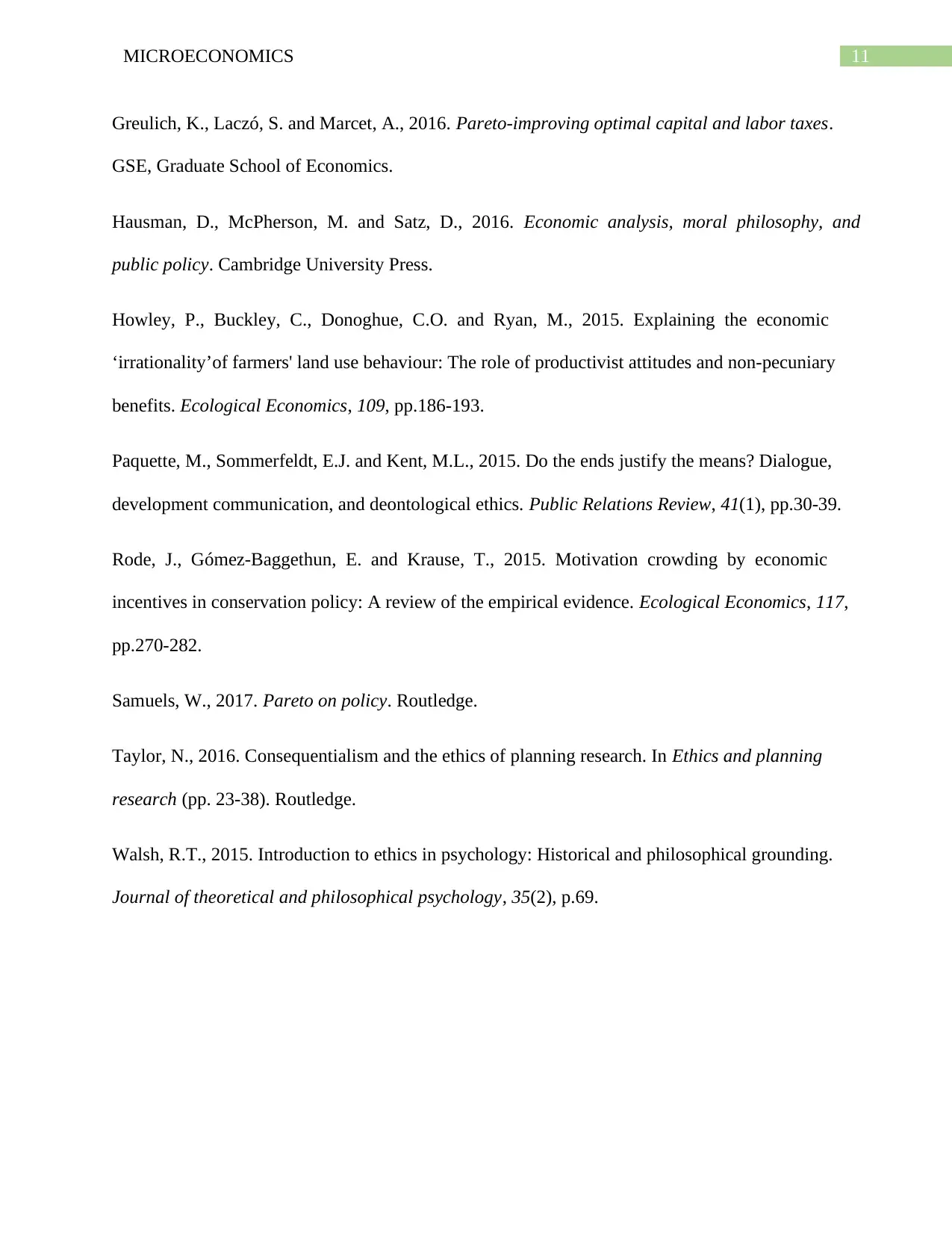
11MICROECONOMICS
Greulich, K., Laczó, S. and Marcet, A., 2016. Pareto-improving optimal capital and labor taxes.
GSE, Graduate School of Economics.
Hausman, D., McPherson, M. and Satz, D., 2016. Economic analysis, moral philosophy, and
public policy. Cambridge University Press.
Howley, P., Buckley, C., Donoghue, C.O. and Ryan, M., 2015. Explaining the economic
‘irrationality’of farmers' land use behaviour: The role of productivist attitudes and non-pecuniary
benefits. Ecological Economics, 109, pp.186-193.
Paquette, M., Sommerfeldt, E.J. and Kent, M.L., 2015. Do the ends justify the means? Dialogue,
development communication, and deontological ethics. Public Relations Review, 41(1), pp.30-39.
Rode, J., Gómez-Baggethun, E. and Krause, T., 2015. Motivation crowding by economic
incentives in conservation policy: A review of the empirical evidence. Ecological Economics, 117,
pp.270-282.
Samuels, W., 2017. Pareto on policy. Routledge.
Taylor, N., 2016. Consequentialism and the ethics of planning research. In Ethics and planning
research (pp. 23-38). Routledge.
Walsh, R.T., 2015. Introduction to ethics in psychology: Historical and philosophical grounding.
Journal of theoretical and philosophical psychology, 35(2), p.69.
Greulich, K., Laczó, S. and Marcet, A., 2016. Pareto-improving optimal capital and labor taxes.
GSE, Graduate School of Economics.
Hausman, D., McPherson, M. and Satz, D., 2016. Economic analysis, moral philosophy, and
public policy. Cambridge University Press.
Howley, P., Buckley, C., Donoghue, C.O. and Ryan, M., 2015. Explaining the economic
‘irrationality’of farmers' land use behaviour: The role of productivist attitudes and non-pecuniary
benefits. Ecological Economics, 109, pp.186-193.
Paquette, M., Sommerfeldt, E.J. and Kent, M.L., 2015. Do the ends justify the means? Dialogue,
development communication, and deontological ethics. Public Relations Review, 41(1), pp.30-39.
Rode, J., Gómez-Baggethun, E. and Krause, T., 2015. Motivation crowding by economic
incentives in conservation policy: A review of the empirical evidence. Ecological Economics, 117,
pp.270-282.
Samuels, W., 2017. Pareto on policy. Routledge.
Taylor, N., 2016. Consequentialism and the ethics of planning research. In Ethics and planning
research (pp. 23-38). Routledge.
Walsh, R.T., 2015. Introduction to ethics in psychology: Historical and philosophical grounding.
Journal of theoretical and philosophical psychology, 35(2), p.69.

12MICROECONOMICS
1 out of 13
Related Documents
Your All-in-One AI-Powered Toolkit for Academic Success.
+13062052269
info@desklib.com
Available 24*7 on WhatsApp / Email
![[object Object]](/_next/static/media/star-bottom.7253800d.svg)
Unlock your academic potential
© 2024 | Zucol Services PVT LTD | All rights reserved.





